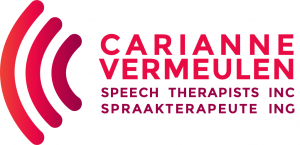What speech and language development can you expect to see at this age?
Understands the concepts “one” and “all”
Points to pictures in a book when named
Identifies and names basic body parts (e.g. “nose”, “ears”)
Follows simple 2-3 step instructions, especially with a gestural cue (e.g. “Go to the kitchen and bring me your plate.”)
Likes to listen to books/stories for longer periods of time
Speech is 50 – 75% intelligible
Expressive vocabulary of 100 – 300 words
Verbalizes toilet needs
Requests items by name (e.g. “Give my ducky.”)
Answers simple questions (e.g. “Where is…”; “Can you…”)
Most frequent question words used in 1-2 word questions are ‘what’ and ‘where’ (e.g. “What is that?” and “Where is daddy?”)
Uses 3-5 or more words in a phrase (e.g. “I want more juice” or “Daddy going to work”)
- Uses some pronouns (e.g. my, mine, you, your, she, he, yours)
- Uses some verb endings (e.g. running) and plurals (e.g. books)
- Gives first name and holds up fingers to show age
- Tries to repair a ‘conversation’ when the listener does not understand
Activities to help stimulate your 2-3 year old child’s speech and language development
Try to expand on what your toddler says. If your child says “more juice”, you can say “more juice please” or “I want more juice”. Let your child hear the correct word order and attempt to imitate your sentence.
Read Books. Read familiar and/repetitive stories. Encourage your toddler to name pictures or respond to simple questions about the story. Remember, you don’t have to read “the words” in a book. Sometimes just telling your own story and simplifying the language for your child can be more beneficial and more fun. Use short sentences. Repeating the story several times is helpful in teaching new words and sentence structures.
Repetition. Emphasize and repeat single words, phrases and sentences for your child to imitate. Simplify your language so that your child can attempt to copy what you said. You can also practise copying multi-syllabic words (e.g. elephant, hamburger).
Help your toddler understand and answer questions. Play a Yes/No game and ask questions such as “Are you a girl?”, “Are you Stacey?”. Also ask questions that require a choice, for example “Do you want juice or milk?”.
Commands. Take turns being the “boss” by telling each other what to do. For example, body parts: “touch your ear, “lift your hands”; actions: “stand up”, “touch the table”.
Let your child help you as you work around the house (e.g. doing the washing, cooking supper, washing vegetables). Describe what you are doing, thinking and planning. Let your child name the things you are using and tell you what you are doing.

